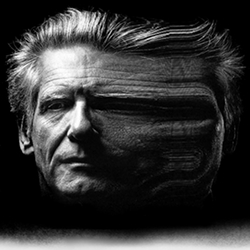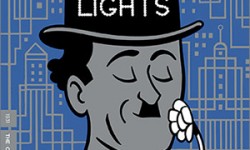
Review: City Lights (1931) - Out on Blu-ray/DVD today - NP Approved
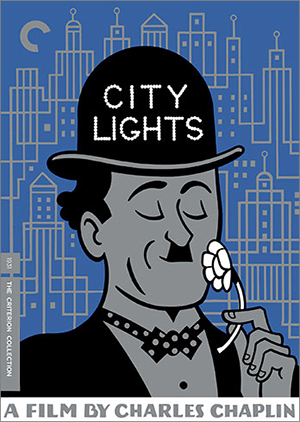 Cast: Charles Chaplin, Virginia Cherrill, Florence Lee
Cast: Charles Chaplin, Virginia Cherrill, Florence Lee
Director: Charles Chaplin
Country: USA
Genre: Comedy , Drama , Romance
Official Trailer: Here
Editor’s Notes: City Lights is out on Blu-ray and DVD today, November 12th, from the Criterion Collection. Special features includes ‘New audio commentary by Charlie Chaplin biographer Jeffrey Vance’, ‘Chaplin Today: “City Lights,” a 2003 documentary on the film’, ‘Chaplin Studios: Creative Freedom by Design’, ‘Archival footage from the production of City Lights, including film from the set, with audio commentary by Chaplin historian Hooman Mehran’, ‘Excerpt from Chaplin’s short film The Champion (1915)’, ‘Trailers’, ‘All content available in both Blu-ray and DVD formats’, and ‘A booklet featuring an essay by critic Gary Giddins and a 1966 interview with Chaplin’.
Criterion continues its marvelous series of Charlie Chaplin Blu-Ray releases with a new edition of Charlie Chaplin’s understated masterpiece, City Lights. In defiance of the popularity of talking pictures at the time of its release, City Lights stands out as definitive proof of film’s ability to expose the fragility of the human soul with its most basic elements of light and movement. The film semi-facetiously describes itself as a “comedic romance in pantomime” but it manages to push the potential for those reductive terms to their furthest limits. It is not a silent film in the strictest sense as Chaplin uses a synchronized score and sound that acts as an affront to talking pictures that exploited the use of sound for its own sake. Films that have all but vanished through the incorruptible filter of time used sound as a novelty device, never exploring its potential in the medium and using its new capacity for synchronized dialogue to say anything worthwhile (Chaplin would later illustrate its true potential as a tool of social protest in his later films, most notably in The Great Dictator with a speech as powerful as it is timeless). City Lights is subversive and daring as Chaplin uses sound to undermine its own novelty and the underutilization of its potential as a tool to address and attack the social inequities and harsh realities of the economic hardships during the Great Depression.
It is not a silent film in the strictest sense as Chaplin uses a synchronized score and sound that acts as an affront to talking pictures that exploited the use of sound for its own sake.
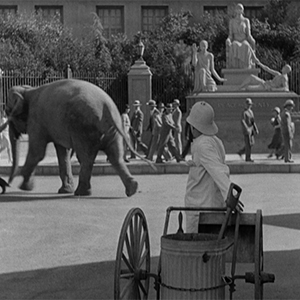 Chaplin’s playful subversiveness reveals itself immediately as politicians speak unintelligibly in duck-like affirmations of the greatness of aristocracy during the unveiling of a pristine new statue. The unveiling finds Chaplin’s iconic tramp sleeping on the statue, confronting the upper-class with the audaciousness of his existence as he assaults their apathetic eyes with his mere presence, ruining the gala event by reminding the insular aristocrats that poverty exists within a stone’s throw of the unsullied paradise they are attempting to create for themselves. His unwashed appearance and tattered attire are an affront to the pristine marble statues and he must quickly find a way down to escape the judging eyes of an over-privileged crowd. Chaplin carries out elaborate site gags as he makes his way down the treacherous statue using the genius of his physical comedy that combines sweetness and stubborn defiance. The tramp may appear undignified as he is trapped on the sword of one of the statue’s figures but no member of the cultural elite would be able to steal his defiant dignity that was forged in the absence of wealth and required no aristocratic approval.
Chaplin’s playful subversiveness reveals itself immediately as politicians speak unintelligibly in duck-like affirmations of the greatness of aristocracy during the unveiling of a pristine new statue. The unveiling finds Chaplin’s iconic tramp sleeping on the statue, confronting the upper-class with the audaciousness of his existence as he assaults their apathetic eyes with his mere presence, ruining the gala event by reminding the insular aristocrats that poverty exists within a stone’s throw of the unsullied paradise they are attempting to create for themselves. His unwashed appearance and tattered attire are an affront to the pristine marble statues and he must quickly find a way down to escape the judging eyes of an over-privileged crowd. Chaplin carries out elaborate site gags as he makes his way down the treacherous statue using the genius of his physical comedy that combines sweetness and stubborn defiance. The tramp may appear undignified as he is trapped on the sword of one of the statue’s figures but no member of the cultural elite would be able to steal his defiant dignity that was forged in the absence of wealth and required no aristocratic approval.
A series of misunderstandings and exploits with a damaged drunken millionaire would find the tramp in the graces of a blind flower girl, and he finds himself infatuated with her charm and beauty, secure in the knowledge that her blindness would ensure that she would never see him for the man of meager means he really was. He takes on odd jobs to try and aid her through a tragic predicament that would leave her homeless if she could not raise twenty-two dollars in back rent in time. He takes on the demeaning job of a street sweeper, opening wonderful opportunities for jokes involving an improbable number of horses promenading down the street followed by the sudden inexplicable appearance of an elephant, an animal that could ruin a street sweeper’s entire day with minimal effort. The tramp’s aloof nature and natural aversion to authority would ensure that this undignified job would not last long, so after his inevitable firing he finds himself in a boxing ring. This sequence of unlucky events leads to one of the most brilliant sequences of physical comedy in the film as his original opponent is forced to go on the lam and he is left to fight a much larger and more “ambitious” opponent.
It underplays its sentimentality and finds genuine emotion through the thoughtful performances of Chaplin and Virginia Cherrill as they found the fragile hearts of their characters and allowed that tender vulnerability to shine through without falling into the maudlin pitfalls of over-expressiveness often found in silent films where filmmakers made feeble attempts at approximating human emotion…
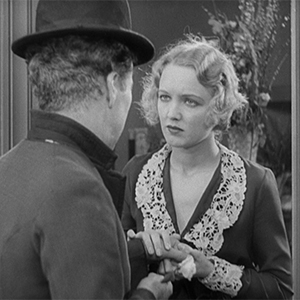 City Lights balances heart, comedy, and a thoughtful cry for humanism as only Chaplin could manage. It underplays its sentimentality and finds genuine emotion through the thoughtful performances of Chaplin and Virginia Cherrill as they found the fragile hearts of their characters and allowed that tender vulnerability to shine through without falling into the maudlin pitfalls of over-expressiveness often found in silent films where filmmakers made feeble attempts at approximating human emotion, lacking the subtlety of real romantic interaction and undermining the audience’s capacity to recognize genuine emotion without the aid of dialogue. These two characters are incapable of any objective forms of communication as the tramp’s sweetly misguided attempts to use his usual modes of silent expression, pantomime borne from an era of silent films. This mode of expression was ineffectual on a woman that could only hear, a reflection of the state of film in the early years of “talkies” as aesthetic and narrative sacrifices were made to accommodate sound. Such missteps are commonplace with each new innovation that promises to redefine the very concept of film, but each new contrivance finds ways to seamlessly integrate with the medium and redefine its potential. Was Chaplin truly using sound ironically as an attack on the vapidity of thoughtless films that used sound simply for its novelty and sudden popularity, or was this reluctance borne from the insecurity that his form of unique physical expression would have no place in a new era of film? Would the “blind” audience appreciate what they saw when the veil was finally lifted and all that was left was the bare soul of a sensitive and vulnerable man, prepared to offer his heart freely to those who would accept it? History has answered that question with a resounding “yes!” and City Lights enjoyed tremendous success at the time of its release and remains one of film’s great treasures, but it was ultimately Chaplin’s insecurities that would push him to create timeless art that wields the same emotional potency now as it did on the day of its release.
City Lights balances heart, comedy, and a thoughtful cry for humanism as only Chaplin could manage. It underplays its sentimentality and finds genuine emotion through the thoughtful performances of Chaplin and Virginia Cherrill as they found the fragile hearts of their characters and allowed that tender vulnerability to shine through without falling into the maudlin pitfalls of over-expressiveness often found in silent films where filmmakers made feeble attempts at approximating human emotion, lacking the subtlety of real romantic interaction and undermining the audience’s capacity to recognize genuine emotion without the aid of dialogue. These two characters are incapable of any objective forms of communication as the tramp’s sweetly misguided attempts to use his usual modes of silent expression, pantomime borne from an era of silent films. This mode of expression was ineffectual on a woman that could only hear, a reflection of the state of film in the early years of “talkies” as aesthetic and narrative sacrifices were made to accommodate sound. Such missteps are commonplace with each new innovation that promises to redefine the very concept of film, but each new contrivance finds ways to seamlessly integrate with the medium and redefine its potential. Was Chaplin truly using sound ironically as an attack on the vapidity of thoughtless films that used sound simply for its novelty and sudden popularity, or was this reluctance borne from the insecurity that his form of unique physical expression would have no place in a new era of film? Would the “blind” audience appreciate what they saw when the veil was finally lifted and all that was left was the bare soul of a sensitive and vulnerable man, prepared to offer his heart freely to those who would accept it? History has answered that question with a resounding “yes!” and City Lights enjoyed tremendous success at the time of its release and remains one of film’s great treasures, but it was ultimately Chaplin’s insecurities that would push him to create timeless art that wields the same emotional potency now as it did on the day of its release.
Related Posts
![]()
Matthew Blevins
![]()
Latest posts by Matthew Blevins (see all)


















